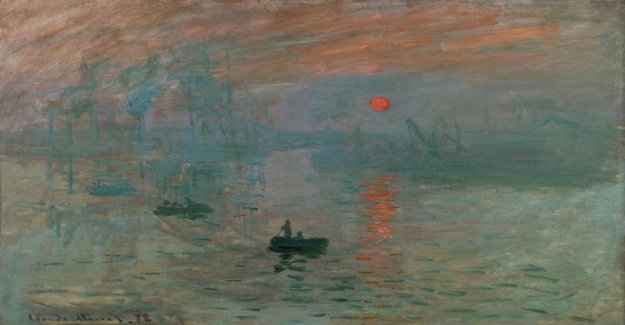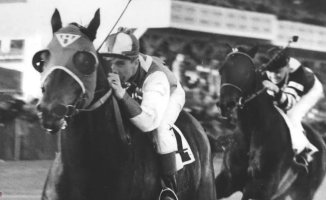Stop time. I believe that the great imperative of the Impressionists, as well as Marcel Proust, was to stop the oblivion that rests, surely, on the facts, pleasant and fleeting everyday life: a walk, a holiday, a discussion between friends, an evening at the theatre.
the cover of The first volume
Until then, the art and literature had been the great events in a direction encomiastica. Claude Monet and Proust tell what, years later, with Fernand Braudel and the school of the "Annales", it would be called "long history". Are the facts the public ones documenting Monet, Renoir, Sisley, Pissarro and Morisot, through their painting en plein air, exposed for the first time on 15 April 1874 in the studio of the photographer Felix Nadar. As well as "public" are the meetings and useless talk of the narrator-Proust, with mrs. Swann, Gilberte, the walks, the discussions at the Hotel in Balbec with Saint-Loup and the Guermantes. The last few decades, painting and literature ceased to be realized for a client, and they have become a public bourgeois, or rather the instruments through which the bourgeois show to aspire to that rank who was a noble through two tools that have always been cultivated in the courts: painting and poetry. But the story, now, are the daily facts and the technique of Monet, as well as of Proust, is that to make the eternal instantaneity of the impression.
Read more
The treasures of art in direct. With the "Courier" the story of Daverio Pierluigi Panza
The discovery of art with Philippe Daverio Franco Manzoni
Impression is derived from the title of a work of Monet:Impression, Sunrise of 1872. From this was coined the name of the movement: the Impressionists. In this painting, the author captures the natural elements of the landscape with the skill of synthesis. Fixed the atmosphere, just as Proust in the pages of the Recherche. The attempt is to stop time. The truth of the work lies in this, that win or lose.
The space, determination of geometry, in the paintings of Monet, and in the pages of Proust, is "filled with objects perceivable" in duration, the duration which is given by the succession of states of consciousness of each individual. The spaces manifest this infinite storage of possibility of sense, and they ask to be remembered through the stigmata of beauty. This is the fil rouge that binds the two creative paths — from the unfinished Breakfast on the grass of the young Monet to the unfinished Jean Santeuil of the young Proust's up to the masterpieces, like The great decorations of the Orangerie in Paris, or in The shadow of young girls in flower.
The data of consciousness, to become atmosphere and the atmospheres become data of consciousness. The perception is fixed on the light, and on atmospheric phenomena that are transfigured. The works of Monet depict the magic of the instant that a moment later will vanish forever. In this, there is a comparison yet with Proust. "Proust shared with Monet, the idea that the impression is the raw material of a work of art, what it is necessary to start to decipher and give expression to the relationship of each artist with the universe in which he lives: the sky, the earth, the waters, beings, and things," writes Giuliana Giulietti in the book Proust and Monet (the Assayer).
In both, the favorite subject is the object of desire that fills the space without that we can grasp it in its completeness, even when Monet spends thousands of brush strokes and Proust thousands of words. Think of the series of water Lilies, so repeated and fragile on the water, in an instant, ready to collapse. And think of Albertine, the"unknowable" that the Narrator-Proust fails to penetrate his authentic life. Life has something elusive, and Monet the fixed tirelessly. Life has something incommunicable behind the ephemeral worldly meetings of the Recherche.
Everything is a struggle for life waged by the beauty. The technique of the impressionists was to use a palette full of colors in a revolutionary way, enhancing the light. The show Impression, sunrise (1872), Rouen Cathedral (1894), the Boulevard des Capucines (1873-74), poppies (1873), The doge's palace in Venice (1908)... Proust does in revealing their feelings in the twirls of his reflections on Gilberte. Monet's painting anticipates the photography, the literature of Proust accompanies psychology. To the side of the Impressionists, Nadar elevated photography to the height of the art: the ability of the photo to "stop" the scenes that pushed this technique until the Exhibition of Fine Arts in Paris in 1859. With writers such as Proust, the journey into the depths of the soul undertaken by Sigmund Freud was wide open.
If the selfie that you take today the young girls and the psychology exhibited on tv, marking the sunset of this experience, more than a century ago, humanity has watched as the image became a psychology and the beauty repeatedly, so, renewed for the umpteenth time, as a tool to combat transience of things.
gift of the first two titles of the series curated by Daverio
Out tomorrow at newsagents with "il Corriere della Sera" Monet, the first volume of the new series, Philippe Daverio tells. A necklace of 50 monographs dedicated to the great masters of art and curated by historian and critic Philippe Daverio (1949-2020). The first volume, as well as Botticelli, the second title in the output the day after tomorrow, is paired free with the purchase of the newspaper. All subsequent releases will be in the newsstands on a weekly basis — from January 5, with Raphael — the price and 5,90 plus the cost of the "Courier". Each monograph is divided into four parts: an introduction, by Daverio; a chapter dedicated to the life of the artist, one of the masterpieces, and a chronological framework. The series opens with Claude Monet (1840-1926), one of the founders of Impressionism and one of the first painters to work en plein air. Her paintings portray landscapes, the gardens, the light of the sun, the shadows. As Déjeuner sur l'herbe (1865-1866), which is kept today (a fragment) at the Musée d'orsay in Paris: it is the "remaking" of the scandalous the eponymous painting by Édouard Manet, and Monet discovered at the Salon des Refusés (the exhibition in paris of 1863 with the works rejected from the Salon's official) and will try to reproduce set his stories in the forests of Chailly. The necklace in the aedicule is a tribute to the orator, who died on 2 September last. In his career Daverio is a professor, television host, and writer, and was awarded by the president of the Republic, the French order of the Légion d'honneur, and president of the Italian Republic, of the Knighthood of arts and letters. Among the upcoming releases: Raphael (January 5); Caravaggio (January 12); Michelangelo (January 19). (j. ch.)












